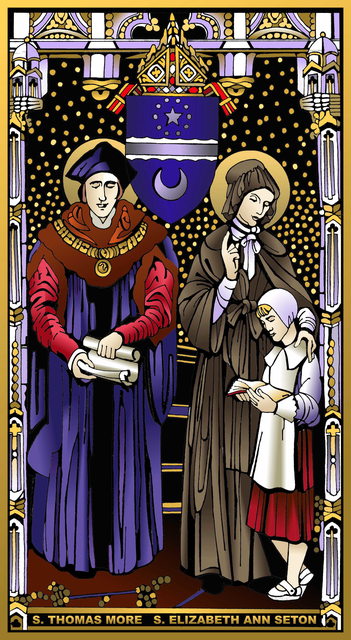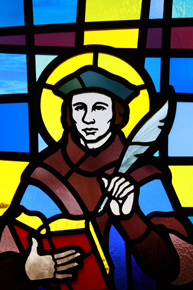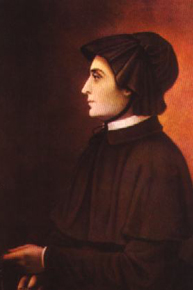The history of Catholicism in Northern Virginia began 400 years before the establishment of the Diocese of Arlington.
Catholicism in the Commonwealth
- 1570: Jesuit Father Juan Baptista de Segura and companions were brutally killed in the Virginia wilderness near what is now Williamsburg.
- 1647: Catholicism in Virginia was revived when Governor Giles Brent of Maryland and his sister Margaret maintained the first Catholic settlement in Virginia as one that embraced religious tolerance.
- 1650: Pope Urban VIII established the Prefecture Apostolic of Virginia, entrusting it to the Capuchin Fathers, and appointed Father Martial, O.F.M. Cap., its first Prefect Apostolic. Also, James II of England granted his Proclamation of Religious Tolerance.
- 1785: Thomas Jefferson's Act for Establishing Religious Freedom decreed that Catholics were free to worship openly in the Old Dominion and the Church began to grow in the area.
- 1795: Thanks in part to George Washington, the Basilica of St. Mary in Alexandria became the first Catholic church in Virginia.
- 1820: Pope Pius VII decreed that the Commonwealth of Virginia (including what is now West Virginia) would be contained in the new Diocese of Richmond. In actuality, the Diocese of Richmond was governed by Baltimore until 1841.
- 1972: The priests of the Alexandria and Arlington Deaneries requested the Bishop John J. Russell, Richmond 's 10th Bishop, to initiate the process toward the establishment of a new diocese in their part of the Commonwealth.
The Diocese of Arlington
- August 13, 1974: Bishop Thomas J. Welsh, auxiliary of Philadelphia and rector of St. Charles Borromeo Seminary in Overbrook, Pennsylvania, was installed in St. Thomas More Church as the first Bishop of Arlington. St. Thomas More Church was elevated to become the new diocesan cathedral.
- 1974: The Diocese of Arlington had more than 136,000 Catholics, 60 diocesan and 33 religious priests, 49 parishes and 7 missions.
- 1974-1983: Bishop Welsh opened 4 elementary schools, 1 high school and 6 parishes and dedicated 11 new churches. He was also instrumental in the founding of Christendom College in Front Royal, the then-Notre Dame Institute in Alexandria, and Catholic Distance University.
- 1983-1998: Bishop John R. Keating was named Arlington's second Bishop. Bishop Keating served until his death on March 22, 1998 and is best remembered for his encouragement of vocations during the continued rapid growth of the Diocese. He ordained 84 men and dedicated more than 20 new churches and 7 schools.
- 1999: More than 336,000 Catholics in the Diocese welcomed Bishop Paul S. Loverde to Arlington. Bishop Loverde established four primary goals for our Diocese: evangelization, unity, reconciliation and service.
- 2016: Pope Francis announced Bishop Michael F. Burbidge as the fourth Bishop of the Catholic Diocese of Arlington. In December of that year, he was installed at the Cathedral of St. Thomas More.
- 2017 - Bishop Burbidge announced the creation of the Diocese of Arlington's 70th parish - St. Bridget of Ireland in Berryville. Prior to 2017, St. Bridget of Ireland in Berryville was a mission of Sacred Heart of Jesus Parish in Winchester.
- 2018 - Bishop Burbidge established two new missions - St. Gabriel Mission in Manassas Park and Our Lady of LaVang Mission in Chantilly. Three priests were bestowed with the papal honor of “Chaplain to His Holiness” by Pope Francis and given the title “Monsignor” - Rev. Msgrs. Robert Avella, John Cregan, Stanley Krempa.
History of Diocese of Arlington Copyright, Arlington Catholic Herald. Reprinted with Permission
Past Bishops of the Diocese of Arlington
Learn about the Diocese of Arlington's past bishops.

Our Patron Saints
Saints Thomas More and Elizabeth Ann Seton have been designated as the patron saints of the Diocese of Arlington. You can learn more about them below.

Saint Thomas More
Saint Thomas More is the patron saint for the Diocese of Arlington and is also the patron saint for politicians, statesmen, lawyers and widowers. His feast day is on June 22nd.
Biography
- 1478 - Born in London of a respectable family, Thomas was placed in the service of the Archbishop of Canterbury, John Morton, Lord Chancellor of the Realm. He later studied law at Oxford and London.
- 1504 - Thomas was elected to Parliament for the first time under King Henry VII.
- 1529 - He was appointed by the King to the post of Lord Chancellor. The first layman to occupy this position, Thomas faced an extremely difficult period, as he sought to serve King and country.
- 1532 - Not wishing to support Henry VIII's intention to take control of the Church in England, he resigned. The king had him imprisoned in the Tower of London, but Thomas refused to take the oath requested of him. Condemned by the Court, he was beheaded.
Related Links
Credit
Text for biographical information about Saint Thomas More: Pope John Paul II's Apostolate Letter on Proclaiming Saint Thomas More Patron of Statesmen and Politicians.

Saint Elizabeth Ann Seton
Saint Elizabeth Ann Seton is the secondary patron of the Diocese of Arlington. She is also the patron of Catholic schools. Her feast day is on January 4.
Biography
- 1774 - Elizabeth Bayley was born into a prominent Anglican family in New York.
- 1803 - The Seton family fortune collapsed and her husband William had developed tuberculosis. Elizabeth, William and their eldest daughter Anna Maria, traveled to the gentler climate of Italy. Despite their efforts, William died in Pisa, Italy, leaving Elizabeth a widow at the age of 29, with five young children, all under eight years of age. While Elizabeth and Anna waited to return to the U.S., the Filicchi family provided them hospitality and introduced Elizabeth to Catholicism.
- 1805 - Elizabeth's devotion to Our Lady and her hunger for Christ in the Eucharist intensified. At the age of thirty, she received her First Holy Communion.
- 1808 - Elizabeth, went to Baltimore Md. to help the Sulpician priests form a school for the religious education of children. Elizabeth took vows of chastity and obedience and was given the title “Mother Seton.”
- 1821 - Elizabeth died in Emmitsburg.
- 1975 - Pope Paul VI canonized Elizabeth and her remains are in the Basilica dedicated to her in Emmitsburg, MD.
Interesting Facts
Credit
Text for biographical information from the saints were taken from the Saint Elizabeth Ann Seton Shrine website.